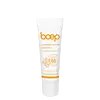What's inside
What's inside
 Key Ingredients
Key Ingredients

 Benefits
Benefits

 Concerns
Concerns

 Ingredients Side-by-side
Ingredients Side-by-side

Water
Skin ConditioningZinc Oxide
Cosmetic ColorantCaprylic/Capric Triglyceride
MaskingDicaprylyl Ether
EmollientGlyceryl Stearate
EmollientGlycerin
HumectantCetearyl Alcohol
EmollientPolyhydroxystearic Acid
EmulsifyingBrassica Campestris/Aleurites Fordi Oil Copolymer
Skin ConditioningSorbitan Caprylate
EmulsifyingSilybum Marianum Ethyl Ester
Skin ConditioningCocos Nucifera Oil
MaskingPongamia Pinnata Seed Extract
Skin ConditioningTocopherol
AntioxidantXanthan Gum
EmulsifyingSodium Polyphosphate
Sodium Stearoyl Lactylate
EmulsifyingBenzyl Alcohol
PerfumingWater, Zinc Oxide, Caprylic/Capric Triglyceride, Dicaprylyl Ether, Glyceryl Stearate, Glycerin, Cetearyl Alcohol, Polyhydroxystearic Acid, Brassica Campestris/Aleurites Fordi Oil Copolymer, Sorbitan Caprylate, Silybum Marianum Ethyl Ester, Cocos Nucifera Oil, Pongamia Pinnata Seed Extract, Tocopherol, Xanthan Gum, Sodium Polyphosphate, Sodium Stearoyl Lactylate, Benzyl Alcohol
Water
Skin ConditioningC12-15 Alkyl Benzoate
AntimicrobialDibutyl Adipate
EmollientButyl Methoxydibenzoylmethane
UV AbsorberDicaprylyl Carbonate
EmollientDicaprylyl Ether
EmollientTapioca Starch
Glycerin
HumectantPhenylbenzimidazole Sulfonic Acid
UV AbsorberBis-Ethylhexyloxyphenol Methoxyphenyl Triazine
Skin ConditioningEthylhexyl Triazone
UV AbsorberNiacinamide
SmoothingDiethylhexyl Butamido Triazone
UV AbsorberPentylene Glycol
Skin ConditioningUndecane
EmollientSodium Stearoyl Glutamate
CleansingCetyl Alcohol
EmollientGlyceryl Stearate
EmollientSodium Hyaluronate
HumectantTridecane
PerfumingCaprylyl Glycol
EmollientDecylene Glycol
Skin ConditioningEctoin
Skin ConditioningSodium Hydroxide
BufferingEthylhexylglycerin
Skin ConditioningTocopheryl Acetate
AntioxidantXanthan Gum
EmulsifyingMicrocrystalline Cellulose
AbsorbentCellulose Gum
Emulsion StabilisingWater, C12-15 Alkyl Benzoate, Dibutyl Adipate, Butyl Methoxydibenzoylmethane, Dicaprylyl Carbonate, Dicaprylyl Ether, Tapioca Starch, Glycerin, Phenylbenzimidazole Sulfonic Acid, Bis-Ethylhexyloxyphenol Methoxyphenyl Triazine, Ethylhexyl Triazone, Niacinamide, Diethylhexyl Butamido Triazone, Pentylene Glycol, Undecane, Sodium Stearoyl Glutamate, Cetyl Alcohol, Glyceryl Stearate, Sodium Hyaluronate, Tridecane, Caprylyl Glycol, Decylene Glycol, Ectoin, Sodium Hydroxide, Ethylhexylglycerin, Tocopheryl Acetate, Xanthan Gum, Microcrystalline Cellulose, Cellulose Gum
Ingredients Explained
These ingredients are found in both products.
Ingredients higher up in an ingredient list are typically present in a larger amount.
Dicaprylyl Ether is created from caprylic acid. It is a texture-enhancer and emollient.
As an emollient, Dicaprylyl Ether is non-comedogenic. It helps soften and smooth the skin by creating a barrier on top. This barrier helps trap moisture in, helping to hydrate the skin.
Dicaprylyl Ether gives a non-greasy feel and better spreadability to products.
Learn more about Dicaprylyl EtherGlycerin is already naturally found in your skin. It helps moisturize and protect your skin.
A study from 2016 found glycerin to be more effective as a humectant than AHAs and hyaluronic acid.
As a humectant, it helps the skin stay hydrated by pulling moisture to your skin. The low molecular weight of glycerin allows it to pull moisture into the deeper layers of your skin.
Hydrated skin improves your skin barrier; Your skin barrier helps protect against irritants and bacteria.
Glycerin has also been found to have antimicrobial and antiviral properties. Due to these properties, glycerin is often used in wound and burn treatments.
In cosmetics, glycerin is usually derived from plants such as soybean or palm. However, it can also be sourced from animals, such as tallow or animal fat.
This ingredient is organic, colorless, odorless, and non-toxic.
Glycerin is the name for this ingredient in American English. British English uses Glycerol/Glycerine.
Learn more about GlycerinGlyceryl Stearate is a mix of glycerin and stearic acid.
It is used to stabilize the mixing of water and oil ingredients. By preventing these ingredients from separating, it can help elongate shelf life. It can also help thicken the product's texture.
As an emollient, it helps soften skin and supports barrier-replenishing ingredients.
In cosmetics, Glyceryl Stearate is often made from vegetable oils or synthetically produced.
This ingredient may not be fungal-acne safe
Fun fact: The human body also creates Glyceryl Stearate naturally.
Learn more about Glyceryl StearateWater. It's the most common cosmetic ingredient of all. You'll usually see it at the top of ingredient lists, meaning that it makes up the largest part of the product.
So why is it so popular? Water most often acts as a solvent - this means that it helps dissolve other ingredients into the formulation.
You'll also recognize water as that liquid we all need to stay alive. If you see this, drink a glass of water. Stay hydrated!
Learn more about WaterXanthan gum is used as a stabilizer and thickener within cosmetic products. It helps give products a sticky, thick feeling - preventing them from being too runny.
On the technical side of things, xanthan gum is a polysaccharide - a combination consisting of multiple sugar molecules bonded together.
Xanthan gum is a pretty common and great ingredient. It is a natural, non-toxic, non-irritating ingredient that is also commonly used in food products.
Learn more about Xanthan Gum